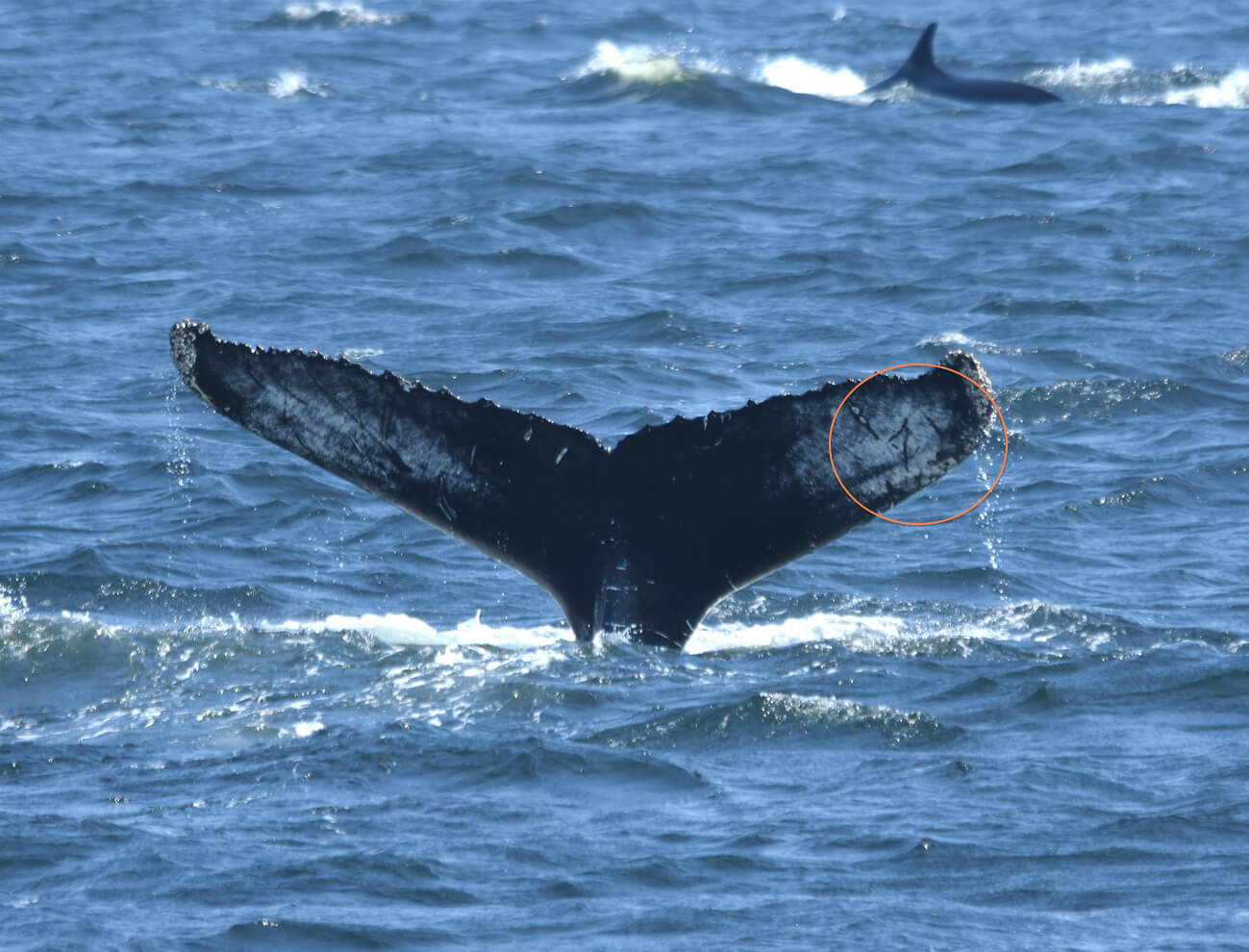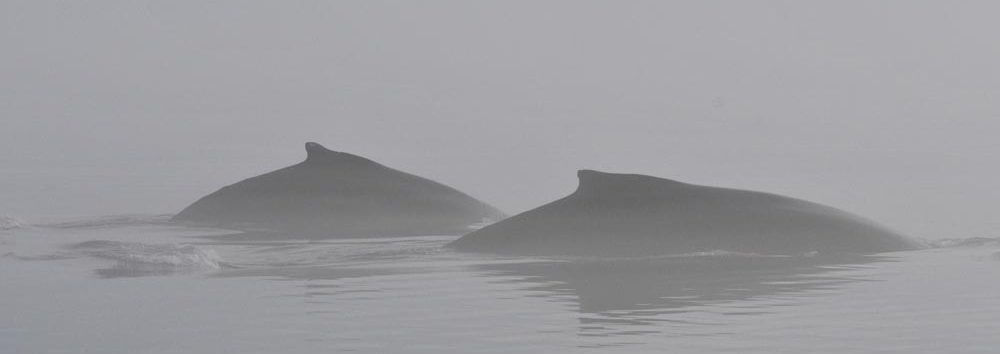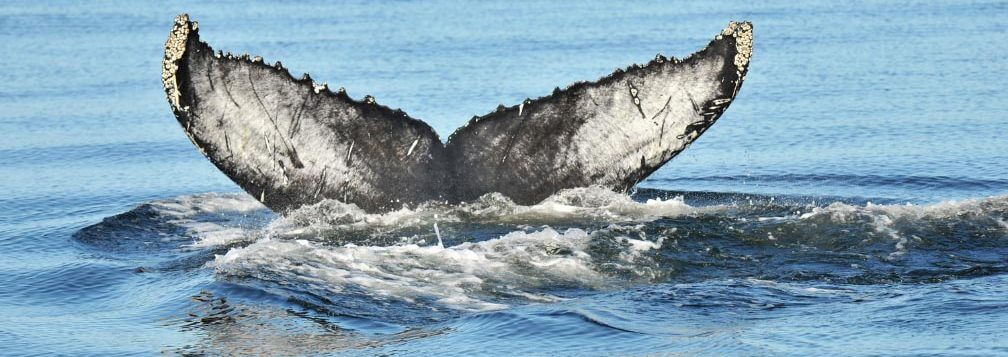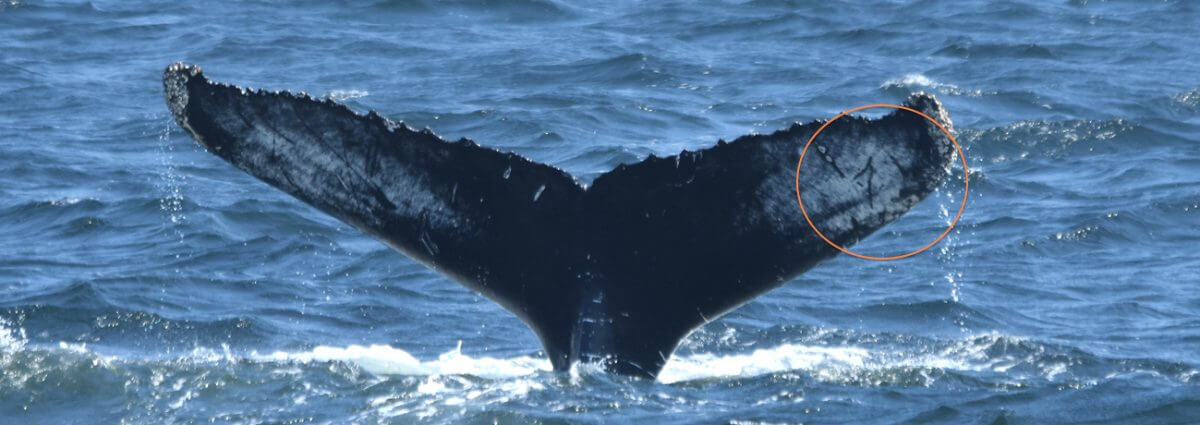Aramis
Humpback Whale


-
ID number
H689
-
Sex
Female
-
Year of birth
2007
-
Known Since
2007
Distinctive traits
We recognize this individual thanks to her undertail colour pattern, which has earned her her name taken from the Three Musketeers. On her right lobe, there are two lines that intersect like two swords.
Life history
Born in early 2007 in the warm waters of the Caribbean, Aramis is the first calf of Tic Tac Toe, an individual regularly seen in the Gaspé Peninsula, the Mingan Islands and the Saguenay-St. Lawrence Marine Park. At the time, they caused quite a stir when they arrived together in the estuary. While humpback whales are frequently seen with their young in the Gulf, this was an unprecedented event in this sector of the St. Lawrence. Like his mother, Aramis has adopted the region. In fact, they are still sometimes seen swimming together.
On July 16, 2013, a team from GREMM and Fisheries and Oceans Canada attached a telemetric tag to her back. In addition to enabling the team to assess the animal’s dive depth and speed, this measure gave Parks Canada the opportunity to collect data on its diet.
In March 2020, Aramis gave birth to her first calf in the Turks and Caicos Islands. Researchers in the region captured the pair using underwater photography techniques, confirming the good news. This calf became the fourth known generation of humpback whales to frequent the St. Lawrence.
During the summer of 2020, Aramis was observed in the Gulf of St. Lawrence, near Minganie. Her mother, Tic Tac Toe, was observed near the estuary with a calf! Tic Tac Toe thus became a mother and grandmother at the age of 23.
On January 22, 2021, she was photographed off the coast of Samana Bay in the Dominican Republic. This bay is recognized as one of the most important breeding grounds for North Atlantic humpback whales.
Observations history in the Estuary
Years in which the animal was not observed Years in which the animal was observed
Latest news from the publications Portait de baleines
Aramis has something that fascinates whale research and observation teams in the region: together with her famous mother Tic Tac Toe, they are the first mother-calf pair to visit the estuary in the history of the marine park! Aramis was not alone when she returned on June 28, after a six-year absence. Tic Tac Toe was swimming alongside her, more than 16 years after her daughter’s birth! Mysterious Aramis did not show her tail fluke, however. The GREMM research team was nevertheless able to identify the young female thanks to the distinctive features of her dorsal fin.
Named for the marks on her tail fluke—reminiscent of the swords used by the famous musketeer of the same name—Aramis became a mother for the first time in 2020 in the Turks and Caicos Islands, a place frequented by humpback whales during the winter. This good news was confirmed by underwater photos taken by scientists in the region. However, the young mother has not yet been observed with a calf in the estuary. Will we one day be able to see three generations of whales, Tic Tac Toe, Aramis, and her calf, together in the St. Lawrence?
At last, a familiar humpback has arrived in the Marine Park! We recognize this individual thanks to her undertail colour pattern, which has earned her her name taken from the Three Musketeers. On her right lobe, there are two lines that intersect like two swords. Aramis has been observed in the Estuary since 2007, the year she was born. She is thus 9 years old. Sometimes she is observed alone, sometimes accompanied by her mother, Tic Tac Toe. In 2007, this duo represented the first observation of a humpback mother-calf pair swimming together in the history of the Marine Park. Perhaps one day we will have the chance to see Aramis accompanied by a young of her own…
Aramis was admired from multiple angles during her time in the Marine Park. Some observers saw her floating on the surface, exposing the tip of her large dorsal fin. This resting behaviour is known as “logging”. Others also observed her accompanied by a young humpback, the calf of Fleuret, swimming by her side in near synchronized fashion. Associations between rorquals are poorly documented. In toothed whales, they have been studied in sperm whales, belugas and killer whales, where individuals of the same species form long-term partnerships that last for years. In contrast, in baleen whales such as rorquals, associations seem to be more temporary and short-lived. Why group together? To reduce the risk of predation? To increase one’s chances of finding food? A hunting strategy? Group formation and the number of individuals composing the group vary not only based on the species, but also on the environment being used. In the St. Lawrence, rarely are large groups of humpbacks observed feeding, as is sometimes observed in other feeding grounds.
The name of Aramis was inspired by the colour pattern under her tail. The two lines on her right lobe resemble two swords that cross like those of musketeers. Aramis was first seen in the Estuary in 2007, the year she was born. She was accompanied by her mother Tic Tac Toe, an individual often observed in the Gaspé, the Mingan Islands and in the Saguenay–St. Lawrence Marine Park. Aramis was Tic Tac Toe’s first calf. The two of them are sometimes still observed swimming together. Since then, Aramis has been seen every year in the Marine Park. This season she was seen several times in the company of Gaspar, another humpback. As humpbacks reach sexual maturity at about 5 years, 8-year-old Aramis would therefore be old enough to reproduce. One day we might be lucky enough to see her in the area with a calf of her own.
Humpback whales leave the cold, rich waters waters in the autumn and migrate to the warmer Caribbean for breeding and calving. These warm waters offer more favourable conditions for those activities. For some individuals, migration is not critical. For example, in any given year, some juvenile males are not competitive enough to reproduce and some females do not give birth or mate. It is therefore more advantageous for these individuals to stay where food is more plentiful, rather than travelling thousands of kilometres to warm but nutrient-poor waters. As testified by some observers, it is not unheard of to observe humpbacks or other whales during the cold winter months.
Born in 2007 in the Caribbean, the humpback whale Aramis accompanied her mother Tic Tac Toe to her feeding grounds during the summer of that same year, first in Minganie, then here in the Saguenay–St. Lawrence Marine Park. This caused quite a stir: while humpback whales are frequently seen with their young in the Gulf, this was an unusual pair for the area. In fact, as far as anyone can remember, it was the first time. Tic Tac Toe, a young female who was having her first calf, is a regular visitor to the marine park, a behavior that has become common among this species since the late 1990s. Like her mother, Aramis has adopted the region.
She arrived there earlier this week, after a notable visit to Minganie, where she was photographed by MICS. A young six-year-old female, she has probably reached sexual maturity: will it soon be her turn to be accompanied by a calf?
On July 16, a joint GREMM–Fisheries and Oceans Canada team placed a telemetry tag on Aramis’ back. Deployed using a long pole and secured with a suction cup, the tag emits a radio signal each time Aramis surfaces and records the whale’s depth and speed every second. At the same time, Parks Canada is studying the presence of prey where the whale is located. This will answer many questions about whale feeding habits!
That’s it, there’s finally a humpback whale in the marine park: Aramis, a young female born in early 2007, brought here by her famous mother Tic Tac Toe the following summer, and visiting us for the fifth year in a row. It should be noted that this was the very first observation of a mother-calf pair of this species in the history of the marine park’s whale watching industry. Spotted and identified by GREMM on Sunday morning in the South Cliff area, she was seen breaching five times on Tuesday morning by Parks Canada’s L’Alliance vessel, then spotted taking a rather long nap by several excursion boats that same afternoon.
According to MICS, which manages the central catalog of this species for the St. Lawrence (776 individuals known to date), Aramis had not been seen in the Gulf this year before her arrival in the marine park, whereas the opposite is true for Tic Tac Toe, who was spotted about a month ago north of Anticosti Island but not yet here.
Aramis’ annual returns to the estuary since 2007 reflect a behavior that is widespread among humpback whales: young whales return to the feeding grounds chosen by their mothers, with whom they have stayed for one year, rarely two. Born in 2007 in the Caribbean and now 4 years old, Aramis will soon reach sexual maturity, which generally occurs around the age of 5 in humpback whales. Will we soon see Aramis accompanied by her very first calf? Or even her and her mother Tic Tac Toe bringing their respective offspring?
The name “Aramis,” due to the marks resembling crossed swords on the right lobe of her tail (hence the reference to the musketeer), was the result of a contest held by MICS and GREMM in 2007, in which people in the whale watching industry were asked to vote for their choice from among five different names.




